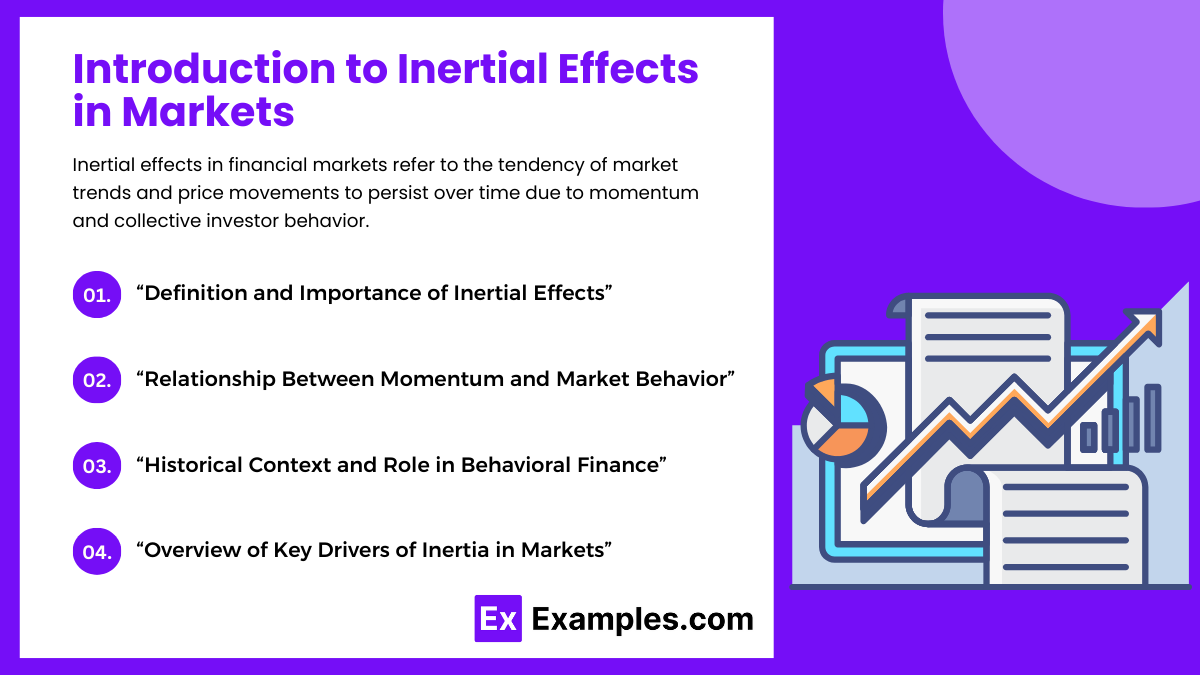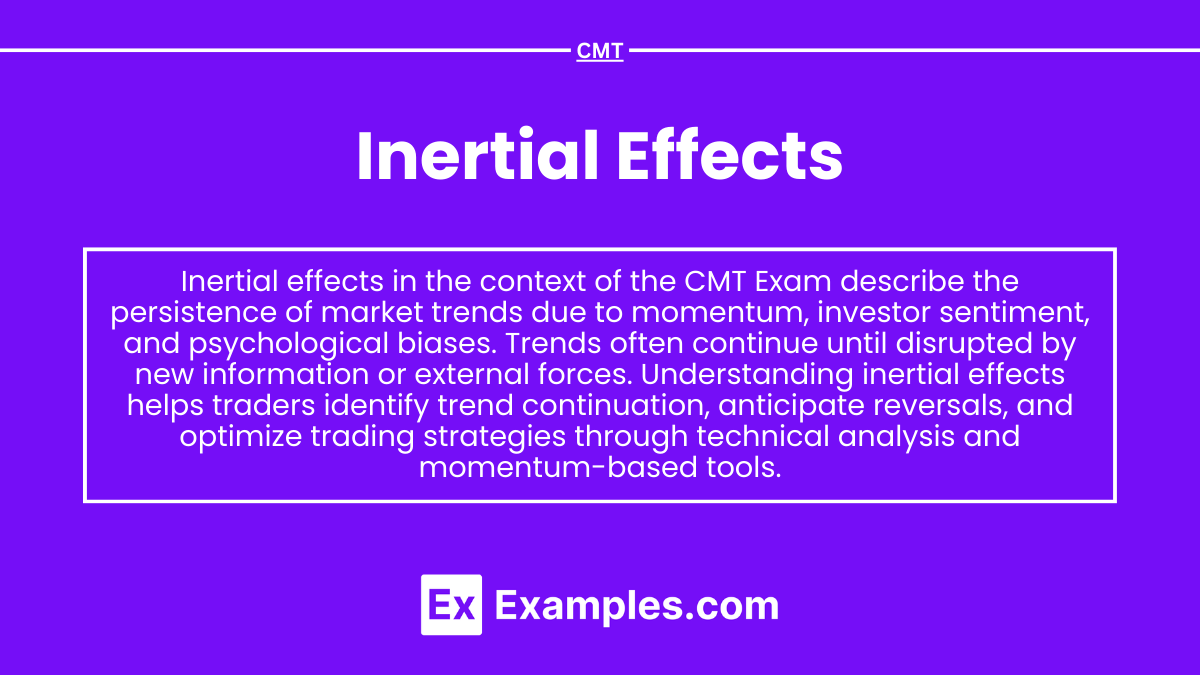Understanding inertial effects is crucial for the CMT Exam, as they describe how market trends persist due to momentum and investor sentiment. Mastery of this concept helps explain trend continuation, reversals, and lagging reactions to new information. This knowledge provides insights into price movements and technical analysis, essential for effective market strategies.
In studying “Inertial Effects” for the CMT Exam within “Section III: Topics in Behavioral Finance,” you should learn how momentum and investor sentiment influence market trends and price persistence. Analyze how inertia leads to trend continuation, delays reactions to new information, and contributes to market patterns such as trend-following behavior. Evaluate technical analysis tools that measure momentum and identify when trends may persist or reverse. Additionally, explore how inertial effects impact market cycles and sentiment-driven trading strategies, applying your understanding to predict and adapt to market movements with greater accuracy and timing for CMT Level 2 proficiency.
Introduction to Inertial Effects in Markets

Inertial effects in financial markets refer to the tendency of market trends and price movements to persist over time due to momentum and collective investor behavior. This concept highlights how past trends influence future price movements, creating opportunities for traders to capitalize on sustained patterns or identify potential reversals. Understanding inertial effects is critical for Chartered Market Technicians (CMTs) as it helps explain why trends often continue beyond what traditional fundamental analysis might predict.
1. Definition and Importance of Inertial Effects
Inertia in markets refers to the persistence of price movements or trends, driven by the collective actions of market participants, psychological biases, and technical factors. It is important because it underpins many trading strategies, such as trend-following, and helps explain why prices often continue to move in one direction even in the face of contrary data.
2. Relationship Between Momentum and Market Behavior
Inertia is closely tied to momentum, a phenomenon where securities that have performed well in the past continue to do so, while those that have underperformed continue to lag. Momentum-driven trends occur due to herd behavior, investor sentiment, and feedback loops where rising prices attract more buyers, further fueling the trend.
3. Historical Context and Role in Behavioral Finance
Inertial effects have been observed in historical market movements, such as prolonged bull or bear markets, where trends persist for extended periods. Behavioral finance explains this phenomenon through psychological biases like herd behavior, overconfidence, and reluctance to deviate from prevailing market sentiment. Historical events provide a basis for understanding how inertia shapes market cycles.
4. Overview of Key Drivers of Inertia in Markets
Several factors contribute to inertial effects, including technical drivers (such as moving averages and momentum indicators), emotional factors (like fear or greed), and behavioral biases (such as loss aversion). These drivers create a self-reinforcing cycle where market participants collectively push prices in a particular direction, sustaining momentum even when fundamentals may not fully justify it.
Momentum and Trend Continuation

Momentum and trend continuation are fundamental concepts in market analysis that describe the tendency for assets or markets to move in the same direction for an extended period. When a trend has established upward or downward momentum, it often continues due to various psychological, technical, and market dynamics. Understanding momentum and its driving forces is crucial for Chartered Market Technicians (CMTs) in developing and executing trading strategies that leverage trend persistence.
1. Momentum Indicators and Their Use
Momentum indicators are tools used to measure the strength and persistence of a price trend. Common examples include moving averages, the Relative Strength Index (RSI), and the Moving Average Convergence Divergence (MACD). These indicators help traders identify the direction and magnitude of trends, providing signals for entry, exit, and potential reversals. For instance, a stock crossing above its moving average may signal a continuation of a bullish trend.
2. Causes of Trend Continuation
Several factors contribute to the persistence of trends in financial markets:
- Herd Behavior: When a large number of investors follow the same buying or selling signals, their collective actions can reinforce and extend a trend.
- Positive Sentiment: Optimistic market sentiment, fueled by strong earnings, economic data, or positive news, can drive prices higher, creating a feedback loop that attracts more buyers.
- Technical Factors: Technical levels, such as support and resistance, act as psychological anchors that can sustain or reverse trends. When these levels are breached, momentum can accelerate as traders pile in, expecting further continuation.
3. Momentum Trading Strategies
Momentum-based trading strategies seek to capitalize on price trends by riding them until there are signs of a reversal. Examples include:
- Trend-Following Strategies: Buying assets that have shown upward momentum and selling those with downward momentum.
- Breakout Strategies: Entering positions when an asset breaks through a significant support or resistance level, signaling a potential new trend.
By identifying and following trends, traders can profit from the tendency for price movements to persist over time. However, momentum trading also requires vigilance, as market reversals can occur suddenly.
4. Case Studies Demonstrating Momentum and Inertia
Historical market trends illustrate the impact of momentum. For example, the technology bubble of the late 1990s saw tech stocks surge based on speculative momentum, leading to extended price increases until the bubble burst. Similarly, prolonged bear markets often see downward momentum as negative sentiment and selling pressure reinforce price declines.
Delayed Reactions and Market Lag

Delayed reactions and market lag refer to the phenomenon where markets or individual assets are slow to respond to new information or changing conditions. Instead of instantly reflecting new data, prices may move gradually or with a lag, allowing traders to potentially capitalize on discrepancies. This delay is often caused by various psychological biases, market inefficiencies, and structural factors that influence how quickly information is incorporated into prices.
1. Reasons for Delayed Reactions
There are several reasons why markets may react slowly to new information:
- Cognitive Biases: Investors may exhibit biases like anchoring or overconfidence, causing them to downplay or dismiss new data that contradicts their existing beliefs. This can lead to a slow adjustment of prices.
- Lagging Data Interpretation: Some traders may need time to fully digest and understand complex data, such as earnings reports or economic indicators, delaying their response and leading to gradual price movements.
- Market Inefficiencies: In less efficient markets, information dissemination may be slower, and fewer market participants may be available to react promptly, causing price movements to lag behind new developments.
2. Analysis of Market Cycles and Patterns of Lag
Markets often exhibit cyclical behavior, with periods of rapid adjustment followed by slower consolidation. During market upswings, positive news may be incorporated quickly, while negative news may lag due to reluctance to change sentiment. Conversely, in down markets, bad news may be quickly absorbed, while good news can take longer to change investor perceptions. Identifying these lagging patterns helps traders anticipate how markets may respond to upcoming events or shifts in sentiment.
3. Impact of Inertia on Price Reversals and Corrections
Delayed reactions can create inertia, where prices continue in the direction of an established trend, even after the fundamental basis for that trend changes. This can lead to overextended rallies or sell-offs. When market participants finally recognize the change, sharp reversals or corrections may occur as prices adjust quickly to align with new realities. Understanding these dynamics can help traders prepare for and react to potential turning points.
4. Identifying Signals of Potential Lagging Trends
Technical analysis tools, such as moving averages, trendlines, and volume analysis, can help identify potential lagging trends and delayed reactions. For example, a divergence between a stock’s price movement and an indicator like the RSI may signal that a lagging trend is losing momentum, potentially indicating an upcoming reversal. By recognizing these signals, traders can better time their trades to capitalize on delayed market reactions.
Applying Inertial Effects in Trading Strategies

Inertial effects, characterized by the persistence of market trends and price movements due to momentum, offer valuable insights for developing trading strategies. By understanding and applying these effects, traders can identify opportunities for profit, anticipate market reversals, and manage risks effectively. Leveraging inertial effects allows traders to capitalize on the natural tendency of markets to continue moving in a particular direction until external forces or changing conditions disrupt them.
1. Techniques for Measuring and Capitalizing on Momentum
Successful application of inertial effects starts with accurate measurement of momentum. Technical indicators such as moving averages, Moving Average Convergence Divergence (MACD), and the Relative Strength Index (RSI) can be used to gauge the strength and direction of a trend. Traders use these indicators to confirm trends, identify potential entry or exit points, and determine whether momentum is likely to persist or weaken.
2. Risk Management in Momentum-Based Strategies
While trend-following and momentum strategies can be highly profitable, they also carry risks, especially when market conditions change suddenly. Implementing robust risk management practices, such as setting stop-loss orders and using position sizing, is crucial for protecting against sharp reversals. Additionally, employing trailing stops can help lock in gains as a trend progresses while providing a buffer against unexpected downturns.
3. Combining Technical Analysis Tools to Assess Inertial Effects
Incorporating multiple technical analysis tools enhances a trader’s ability to assess and leverage inertial effects. For example, combining moving averages with momentum oscillators like the RSI can provide more accurate signals for trend strength and potential reversals. This multifaceted approach helps minimize false signals and provides a clearer picture of market sentiment and price action.
4. Practical Examples of Inertia-Driven Trading Strategies and Market Timing Techniques
Real-world examples of inertia-driven trading strategies include:
- Trend-Following Strategies: These involve identifying and riding long-term trends using momentum indicators. Traders enter positions in the direction of the prevailing trend and hold until signs of a reversal appear.
- Breakout Trading: Traders capitalize on price movements that break through established support or resistance levels, often indicating the start of a new trend driven by inertial forces.
- Mean Reversion and Countertrend Strategies: In some cases, identifying when momentum is weakening allows traders to anticipate and profit from price corrections or reversals.
Examples
Example 1: Trend Continuation in Bull Markets
During prolonged bull markets, such as the late 1990s tech boom, strong momentum can drive prices higher for extended periods. Positive sentiment, optimism, and herd behavior reinforce upward trends, with more investors joining in as prices rise. This self-reinforcing cycle demonstrates how inertia can sustain price movements well beyond fundamental value.
Example 2: Moving Averages as Momentum Indicators
Traders often use moving averages to assess trend inertia. When a shorter-term moving average (e.g., 50-day) crosses above a longer-term moving average (e.g., 200-day), it can signal strong upward momentum (a “golden cross”). This pattern exemplifies inertia, as prices tend to continue in the direction of the crossover.
Example 3: Market Resistance to Negative News
Inertia can delay reactions to negative news. For example, a stock with strong upward momentum may not immediately react to a minor earnings miss, as investor confidence and momentum sustain the price. Only when sentiment shifts decisively do prices reflect the new reality, often leading to a sharper correction.
Example 4: Breakout Trading Based on Inertia
When a security breaks through a significant resistance level, it often signals strong momentum and trend continuation. Traders use this as an opportunity to capitalize on the inertia driving prices higher. The breakout indicates that buyers are willing to push prices beyond previous limits, often sustaining upward movement.
Example 5: Delayed Reactions to Macroeconomic Data
In some cases, markets may exhibit inertia by responding slowly to new macroeconomic data, such as interest rate changes. While some investors may act immediately, widespread adjustment often occurs gradually as the broader market absorbs the implications. This delayed reaction creates opportunities for traders who anticipate or recognize the lag.
Practice Questions
Question 1:
Which of the following best describes inertial effects in financial markets?
A. Random price movements that have no correlation
B. A tendency for trends to persist due to momentum and investor behavior
C. A sudden reversal in market direction without any warning
D. The immediate incorporation of all available information into prices
Answer: B) A tendency for trends to persist due to momentum and investor behavior
Explanation:
Inertial effects refer to the persistence of market trends due to factors such as momentum, collective investor behavior, and psychological biases. Unlike random movements or immediate reactions, inertial effects emphasize the tendency for price trends to continue until disrupted by external factors or changing market conditions.
Question 2:
Which of the following is a common tool used to measure market momentum and assess inertial effects?
A. Dividend Yield
B. Price-to-Earnings Ratio (P/E)
C. Moving Average
D. Earnings per Share (EPS)
Answer: C) Moving Average
Explanation:
Moving averages are commonly used to measure market momentum and assess the strength of trends, indicating potential continuation or reversals. By smoothing out price data, moving averages help traders identify trends and assess their persistence, making them a useful tool for understanding inertial effects. The other options are financial metrics not specifically focused on momentum.
Question 3:
An investor notices a stock consistently rising despite mixed earnings reports. Which explanation aligns most closely with inertial effects?
A. Market participants are fully rational and incorporate new data instantly.
B. Positive momentum and investor sentiment are driving continued buying.
C. The market is overvalued due to unrelated macroeconomic factors.
D. The stock is reacting randomly without any clear pattern.
Answer: B) Positive momentum and investor sentiment are driving continued buying.
Explanation:
Inertial effects often involve the continuation of a trend due to positive momentum and investor sentiment, even in the face of mixed data. This persistence reflects how market behavior can sustain price movements due to inertia. The other options either describe unrelated phenomena or fail to capture the essence of inertial effects.


